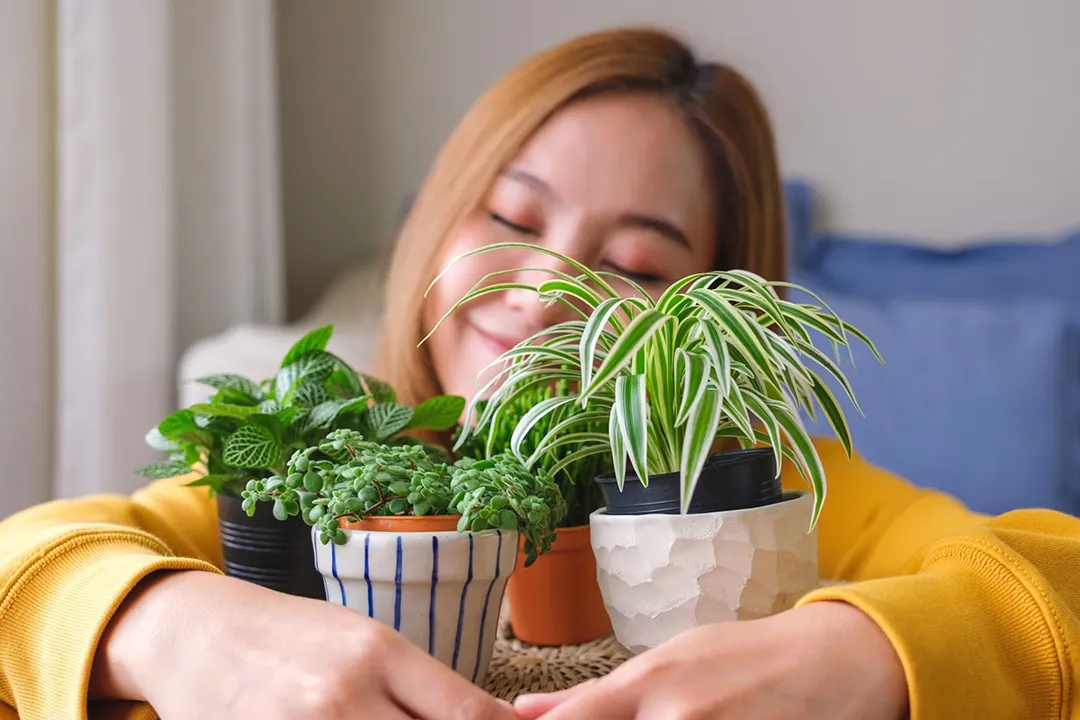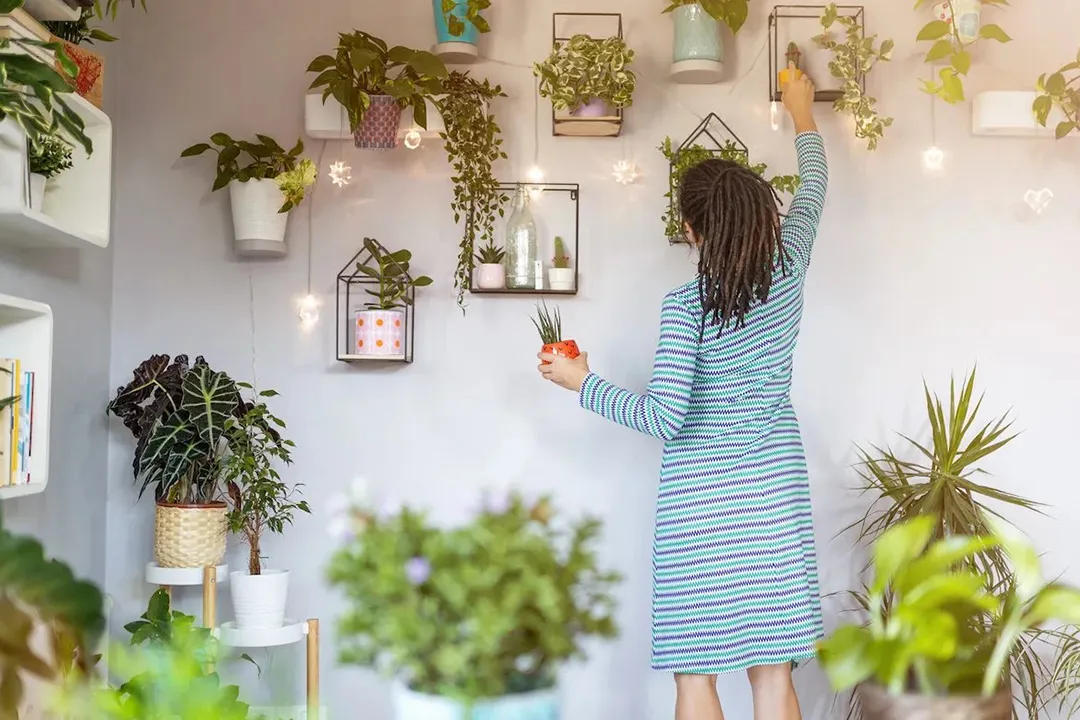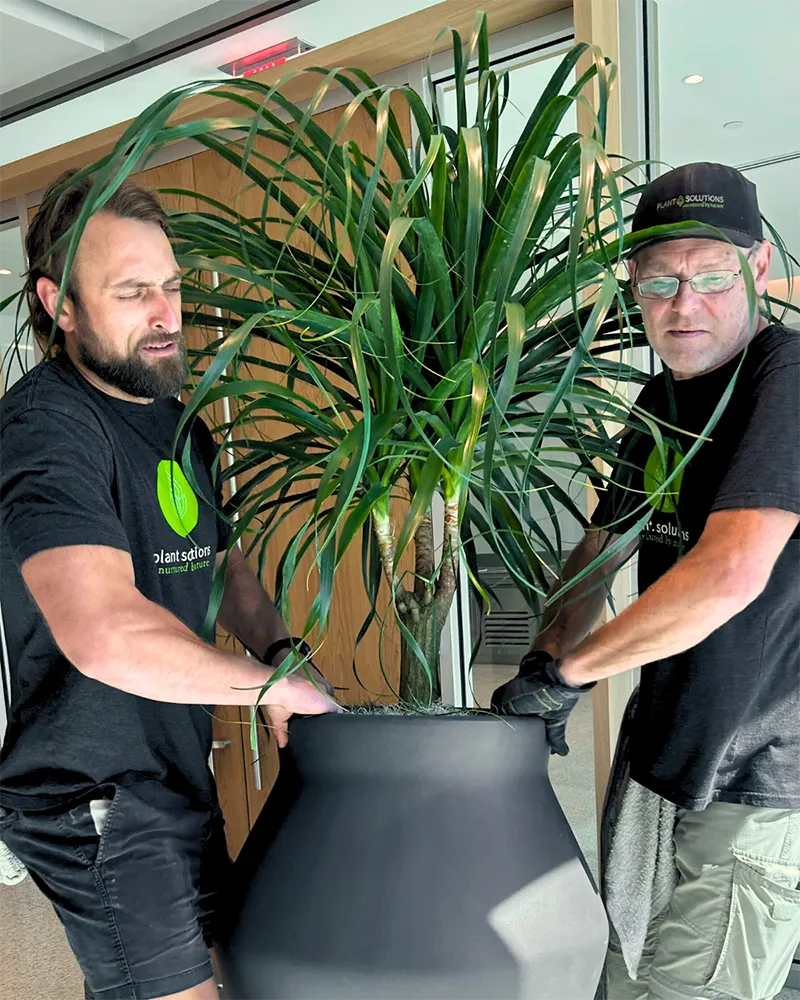In today’s world, where trauma and mental health challenges are increasingly prevalent, the environments we inhabit play a crucial role in our capacity to heal. Hospitals, rehabilitation centers, and community spaces are recognizing that traditional clinical design may fall short when it comes to fostering emotional well-being. That’s where biophilia comes in.
Biophilic design integrates natural elements into built spaces—not just for aesthetics, but for healing. Interior landscaping helps bridge the gap between nature and indoor environments, supporting health and well-being in all kinds of settings. At Plant Solutions, we’ve seen firsthand how the presence of plants, natural textures, and organic forms can support recovery, reduce anxiety, and rebuild a sense of safety. For organizations looking to offer these benefits without the high upfront costs of permanent plant installations, indoor plant rental offers a flexible solution.
How nature supports trauma recovery
Research consistently shows that nature-based environments help regulate the nervous system, reduce symptoms of PTSD, and foster a sense of connection. According to the National Institutes of Health, even brief exposure to natural elements—such as plants, daylight, or organic textures—can reduce stress and support cognitive functioning. For individuals processing trauma, this matters. Trauma severs the feeling of safety in the body—biophilic environments help restore it.

Whether it’s a waiting room, a counseling office, or a group therapy center, the quiet presence of plants creates cues of calm and care. Indoor plant rental services make it easy to design and maintain these restorative environments—without adding responsibilities to clinical staff or facility managers.
Grief, mental health, and the need for softness
Grief and chronic mental health conditions often require long-term support. In these moments, sterile white walls and fluorescent lighting can feel emotionally barren. Biophilic spaces do the opposite—they invite softness, reflection, and growth. Even small interventions, like renting a cluster of ferns or installing MossWallArt™ in a hallway, can shift the emotional tone of a space.
Indoor plant rental provides healthcare and community centers access to seasonal updates, rotating plant types, and professional care. This means the healing environment evolves naturally over time, just like those who inhabit it.
“There is something infinitely healing in the repeated refrains of nature,” wrote Rachel Carson, “the assurance that dawn comes after night, and spring after winter.”

For individuals navigating depression or grief, the soft presence of plants can help create environments that feel less clinical and more supportive. We explore the reason behind this in our 2024 article about plants and mood.
The psychology of greenery
The presence of plants in indoor environments has measurable physiological and psychological benefits. Research shows they can improve attention, reduce cortisol levels, and increase heart rate variability—all of which support emotional regulation (NIH research article PDF). For trauma survivors, this translates to a greater ability to stay grounded in the present moment.

Clients using indoor plant rental for their facilities report noticeable changes: patients engage more fully in group sessions, families feel more at ease in grief-support spaces, and staff members experience less burnout. Plants are not a cure, but they are a companion on the journey.
These findings aren’t limited to clinical spaces. Even in corporate environments, access to greenery has been linked to better focus, reduced stress, and improved emotional regulation. We explore this further in our article on the psychological benefits of plants in the workplace.
How indoor plant rental supports mental health recovery
Referring again to the National Institutes of Health, here are five well-documented ways biophilic design supports emotional resilience and recovery in clinical and community spaces:
- Reduces stress and lowers cortisol levels
- Improves mood and emotional well-being
- Enhances cognitive clarity and attention span
- Accelerates healing and reduces perceived pain
- Fosters social connection and emotional safety
Plant rental applications in hospitals and clinics
The type of indoor plant rental service chosen, along with plant selection and installation styles, can be adapted to meet the unique needs of different clinical spaces. Here are a few examples of how it can be implemented effectively:
- Behavioral health units: Durable, low-maintenance plants in safe containers
- Pediatric wards: Bright foliage and interactive displays for child-friendly engagement
- Therapist offices: Calming greenery that encourages emotional openness
- Waiting areas: Welcoming plant clusters that communicate care

Plant Solutions works closely with facility managers to ensure that plant choices are hygienic, appropriate for the space’s microclimate, and safe for all populations. Because indoor plant rental includes full horticultural service—watering, pruning, cleaning, pest management, and replacements—staff can focus on healing, not plant care.
Reimagining community spaces
Biophilic design isn’t limited to hospitals. It can transform community centers, nonprofit hubs, and transitional housing programs—spaces where healing often begins.
Indoor plant rental helps these organizations maintain warm, dignified environments without overextending their budgets. Whether it’s a mobile plant wall that adds privacy or hanging vines that soften a communal space, these simple additions can make a lasting impact.
Many real-world case studies show how green spaces improve comfort and connection in recovery-focused environments. In Phoenix, Community 43 is one example of a local organization investing in the healing power of plants. Their horticulture therapy program, developed for individuals living with serious mental illness, underscores how plant-based environments can support emotional regulation, social connectedness, and long-term recovery.
For similar organizations designing nature-forward recovery spaces, our goal is to create environments that communicate stability, care, and connection. Read more about this in Horticultural therapy & nature-inspired spaces.

Indoor plant rental is a low-risk, high-impact investment
The flexibility of indoor plant rental makes it a practical fit for any healing-focused organization. You can experiment with different layouts, swap plant types seasonally, and scale your plant presence over time. It’s a smart option for spaces that need to feel grounded and adaptable.
More importantly, indoor plant rental includes everything: professional maintenance, replacements, and routine health checks. You’re not just adding greenery—you’re investing in consistency, care, and a better experience for everyone who walks through the door.
“The creation of a thousand forests is in one acorn.” —Ralph Waldo Emerson

Why indoor plants matter
Many assume healing is about medical intervention, but the physical environment plays a critical role. Spaces that incorporate natural elements help people feel safer, calmer, and more emotionally grounded. Whether it’s a trauma-informed clinic, a grief center, or a community recovery hub, biophilic design supports emotional recovery in ways traditional interiors cannot.
By choosing indoor plant rental, you’re offering more than beauty. You’re offering stability, safety, and a daily reminder that recovery is possible.
Want to bring healing to your space?
Explore how interior landscaping supports well-being in every setting, or learn how living walls and MossWallArt™ create calm, immersive spaces for reflection and recovery. Learn what’s included in every horticultural service or view our latest case studies to see how nature transforms built environments—one plant at a time.
Ready to transform your space into a supportive, healing environment with the beauty and benefits of nature?
